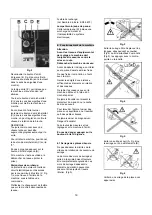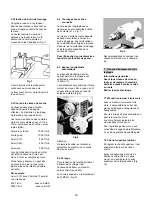
5
The specified values are emission
levels and are not necessarily to be
seen as safe operating levels.
As workplace conditions vary, this
information is intended to allow the
user to make a better estimation of the
hazards and risks involved only.
4.3 Content of delivery
Single tool post
50mm 3-jaw universal chuck
Chuck guard
Splash guard
Assembly kit
Operating manual
Spare parts list.
4.4 Machine Description
Fig 1
A....Chuck guard with micro switch
B….Emergency stop button
C….ON/OFF and speed control knob
D….Yellow overload light
E….Green power light
F….Taistock quill lock knob
G….Tailstock spindle handwheel
H….Pulley cover
I…..3-jaw chuck
J….Cross travel handwheel
K….Toolpost
l…..Lead screw
M….Tailstock lock screw
N…. Longitudinal travel handwheel
5. Transport and start up
5.1 Transport and installation
The machine is designed to operate in
closed rooms and must be bolted to a
solid work bench or table.
Make sure the machine cannot tip!
For packing reasons the machine is
not completely assembled.
5.2 Assembly
If you notice transport damage while
unpacking, notify your supplier
immediately. Do not operate the
machine!
Dispose of the packing in an
environmentally friendly manner.
Clean all rust protected surfaces with
petroleum, diesel oil or a mild solvent.
Attach the crank handles to the hand
wheels ( G, J, N Fig 1).
Attach the chuck guard with 2 pan
head screws
5.3 Mains connection
Mains connection and any extension
cords used must comply with
applicable regulations.
The mains voltage must comply with
the information on the machine
licence plate.
The mains connection must have a
10 A surge-proof fuse.
Only use power cords marked
H07RN-F.
Connections and repairs to the
electrical equipment may only be
carried out by qualified electricians.
5.4 Initial lubrication
The machine must be serviced at all
lubrication points before it is placed
into service!
(see chapter 8 for lubrication)
5.5 Starting operation
Before starting the machine check
the proper chucking (see chapter 6).
Always close the chuck guard and
pulley cover before you start the
machine.
Fig 2
Disengage the emergency stop button
(B, Fig 2) to energize the electrics.
(by rotating in clockwise direction).
The green power light (E) is
illuminated when connected.
Turn the ON/OFF switch (C) in
clockwise direction to start the
machine.
Select the desired spindle speed by
turning the ON/OFF switch (C) further
in clockwise direction.
Note: Always start with a low spindle
speed setting, then gradualy increase
the speed.
Stop the machine by turning the
ON/OFF switch to the OFF position.
In case of an emergency use the
emergency stop button (B).
Disconnect the machine from the
power source if not in use (pull mains
plug).
Fuse protection:
The fuse is located on the rear below
the control panel and protects the
motor and electronic parts.
The fuse may only be changed when
the machine is disconnected from
power source (pull mains plug).
Replacement fuse:
(Jet Article Number: BD3-067F)
Yellow overload light:
The yellow overload light (D) indicates
motor “overload” or “not ready”
condition.
























